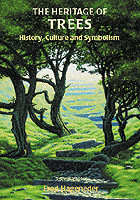Book Review: The Heritage of Trees
The Heritage of Trees is a concisely written anthropological account of tree-worship across several different ages and civilisations


The Heritage of Trees by Fred Hageneder, Floris Books £16.99
Many of us secretly yearn for the day when exciting animals like boar and wolves will once again haunt Britain's bosky shores, even if we are too shy to admit it in public. It says something about the British love of trees and woods
But this is the wrong sort of love for trees - according to Fred Hageneder's new book The Heritage of Trees (History, Culture and Symbolism). Mr Hageneder is a German harpist naturalised to Glastonbury, which may give you some idea of the angle he initially takes on all this.
The introduction baldly states his aims thus - "It is my hope that this book will plant a seed in our time to spread the understanding that a deep respect for living trees, as well as for the symbol of the Tree of Life, remains, and will remain, an undying feature of the universal religion."
It is a shame that Mr Hageneder's first few words are so garbled, because the tone of the introduction jars with the rest of the book. The rest of The Heritage of Trees emerges as a concisely written anthropological account of tree-worship across several different ages and civilisations.
Mr Hageneder has an enviable ability to pinpoint the relevant aspects of whichever tree is under discussion, and move on. He is never ambiguous and seldom dull.
In fact, it is only when referring to his native Germany, and particularly the treatment of the Germanic pagans by Christians, that he really loses his sense of critical detachment. As soon as he's back in the pre-Christian past he regains poise and equilibrium.
Exquisite houses, the beauty of Nature, and how to get the most from your life, straight to your inbox.
Describing, for example, the mutual dependence of early religions, of the Temple of Solomon he writes - 'Although the basic structure was made of stone, the roof and interior were elaborately crafted using the most sacred tree of the Middle East, the Cedar of Lebanon, so that 'no stone was seen' (1 Kings 6:15), but most remarkably the interior designs showed the ancient Mesopotamian image of the Tree of Life..'
Though on the whole he errs on the side of description rather than historical analysis, this is no bad thing. With his impressive breadth of knowledge, and the ability to pollard any tricky subject to its pithy essentials, Mr Hageneder manages to sustain a high level of interest throughout this rather esoteric book.
Country Life is unlike any other magazine: the only glossy weekly on the newsstand and the only magazine that has been guest-edited by His Majesty The King not once, but twice. It is a celebration of modern rural life and all its diverse joys and pleasures — that was first published in Queen Victoria's Diamond Jubilee year. Our eclectic mixture of witty and informative content — from the most up-to-date property news and commentary and a coveted glimpse inside some of the UK's best houses and gardens, to gardening, the arts and interior design, written by experts in their field — still cannot be found in print or online, anywhere else.
